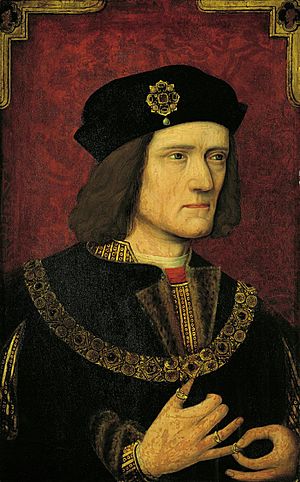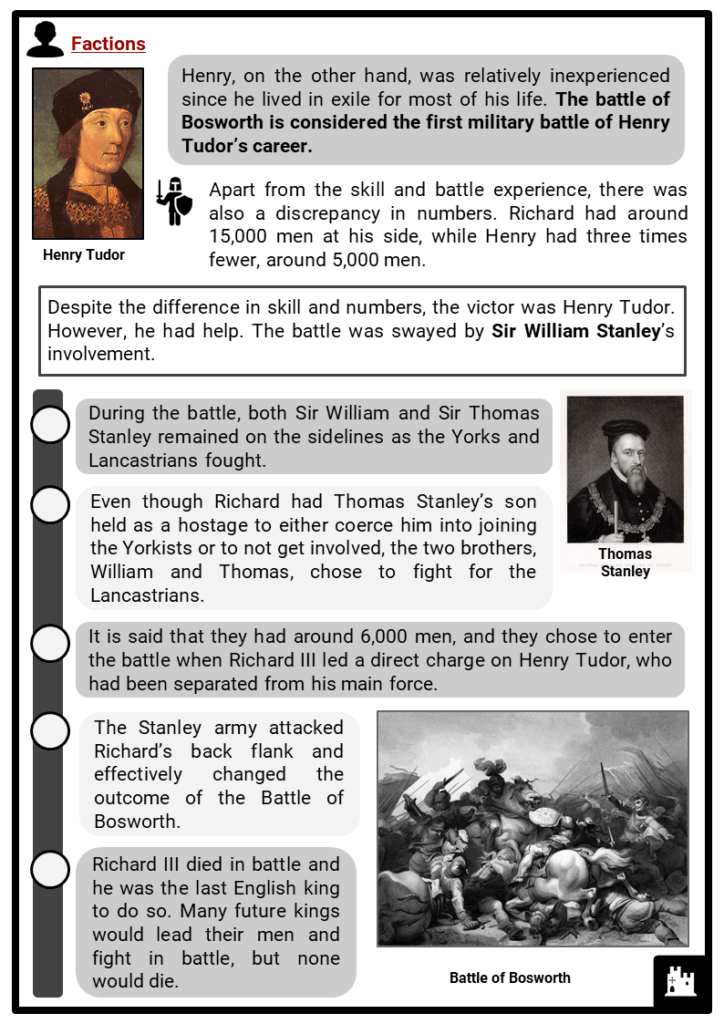How Did King Richard Die
- Born September 8, 1157, Richard the Lionheart was the third legitimate son of King Henry II of England. Often believed to have been the favorite son of his mother, Eleanor of Aquitaine, Richard had three older siblings, William (who died in infancy), Henry, and Matilda, as well as four younger: Geoffrey, Lenora, Joan, and John.
- But it wasn’t because Richard was his favourite son. In fact, the Lionheart is seen by many as having tormented his father to a premature death. Just two days before Henry died, forces loyal to Richard and Philip II of France had defeated the king’s army at Ballans. It was only after this victory that Henry named Richard his heir apparent.
- Richard III died in the thick of battle after losing his helmet and coming under a hail of blows from vicious medieval weapons, new research has shown. Detailed scans of the king's bones show that.
Richard died on 6 April 1199 in the arms of his mother, and thus 'ended his earthly day.' Because of the nature of Richard's death, it was later referred to as 'the Lion by the Ant was slain'.
| Richard of Shrewsbury | |
|---|---|
| Duke of York; Duke of Norfolk; Earl of Nottingham | |
| Born | 17 August 1473 Shrewsbury, Shropshire, England |
| Died | Unknown (presumed c. 1483, 9/10 years old) |
| Spouse | (m. 1478; died 1481) |
| House | York |
| Father | Edward IV |
| Mother | Elizabeth Woodville |
| English Royalty |
| House of York |
|---|
| Edward IV |
Richard of Shrewsbury, Duke of YorkKG (17 August 1473 – c. 1483), was the sixth child and second son of King Edward IV of England and Elizabeth Woodville, born in Shrewsbury. Richard and his older brother, who briefly reigned as King Edward V of England, mysteriously disappeared shortly after Richard III became king in 1483.
Dukedoms[edit]

Prince Richard was created Duke of York in May 1474 and made a Knight of the Garter the following year. From this time on, it became a tradition for the second son of the English sovereign to be Duke of York. He was created Earl of Nottingham on 12 June 1476. On 15 January 1478, in St Stephen's Chapel, Westminster, when he was about 4 years old, he married the 5-year-old Anne de Mowbray, 8th Countess of Norfolk, who had inherited the vast Mowbray estates in 1476. Because York's father's-in-law dukedom had become extinct when Anne could not inherit it, he was created Duke of Norfolk and Earl Warenne on 7 February 1477. When Anne de Mowbray died in November 1481 her estates should have passed to William, Viscount Berkeley and to John, Lord Howard. In January 1483 Parliament passed an act that gave the Mowbray estates to Richard, Duke of York and Norfolk, for his lifetime, and at his death to his heirs, if he had any. The rights of the two co-heirs at law were extinguished; Viscount Berkeley had financial difficulties and King Edward IV paid off those debts. Berkeley then renounced his claims to the Mowbray estate before parliament in 1483. Nothing was done for Lord Howard.
Heir presumptive[edit]
His father died on 9 April 1483. Thus his brother Edward, Prince of Wales, became King of England and was acclaimed as such, and Richard his Heir Presumptive. This was not to last. A priest, now generally believed to have been Robert Stillington, the Bishop of Bath and Wells, testified that Edward IV had agreed to marry Lady Eleanor Talbot in 1461.[1] Lady Eleanor was still alive when Edward married Elizabeth Woodville in 1464. The Regency council under the late King's brother Richard, Duke of Gloucester, concluded that this was a case of bigamy, invalidating the second marriage and the legitimacy of all children of Edward IV by this marriage. Under Gloucester's influence, both Edward and Richard were declared illegitimate and removed from the line of succession on 25 June 1483. The Duke of Gloucester, as the only surviving brother of Edward IV, became King Richard III.
Possible fate[edit]
The Duke of York was sent to the Tower of London, then a royal residence, by King Richard III in mid-1483, where he was held with his brother. They were sometimes seen in the garden of the Tower, but there are no known sightings of them after the summer of 1483. What happened to the two of them—the Princes in the Tower—after their disappearance remains unknown. Tudor History was quick to blame his uncle, Richard.[2]Thomas More wrote that the princes were smothered to death with their pillows, and his account forms the basis of William Shakespeare's play Richard III, in which Tyrrell suborns Forrest and Dighton to murder the princes on Richard's orders. Subsequent re-evaluations of Richard III have questioned his guilt, beginning with William Cornwallis early in the 17th century.[3] In the period before the boys' disappearance, Edward was regularly being visited by a doctor; historian David Baldwin extrapolates that contemporaries may have believed Edward had died either of an illness or as the result of attempts to cure him.[4] In the absence of hard evidence a number of other theories have been put forward, of which the most widely discussed are that they were murdered on the orders of the Duke of Buckingham or by Henry Tudor, Earl of Richmond (later King Henry VII).

Bones reportedly belonging to two children were discovered in 1674 by workmen rebuilding a stairway in the Tower. On the orders of King Charles II, these were subsequently placed in Westminster Abbey, in an urn bearing the names of Edward and Richard.[5] The bones were re-examined in 1933 at which time it was discovered the skeletons were incomplete and had been interred with animal bones. It has never been proven that the bones belonged to the princes.[6]
In 1789, workmen carrying out repairs in St George's Chapel, Windsor, rediscovered and accidentally broke into the vault of Edward IV and Elizabeth Woodville. Adjoining this was another vault, which was found to contain the coffins of two children. This tomb was inscribed with the names of two of Edward IV's children: George, Duke of Bedford, who had died at the age of two; and Mary of York who had died at the age of 14. Both had predeceased the King. However, the remains of these two children were later found elsewhere in the chapel, leaving the occupants of the children's coffins within the tomb unknown.[7]
In 1486 Richard of Shrewsbury's eldest sister Elizabeth married Henry VII, thereby uniting the Houses of York and Lancaster.[8]
Perkin Warbeck[edit]
In 1491 in Cork, Perkin Warbeck, a young man of Flemish origin was proclaimed by a variety of Yorkist supporters led by the Irish city's former Mayor John Atwater to be Richard. He claimed to have escaped from the Tower and spent the intervening years on the run. Over the next six years Warbeck travelled across Europe, receiving recognition from a number of monarchs including Maximilian I, Holy Roman Emperor and James IV of Scotland as 'Richard IV' of England. This support included Margaret of York, the aunt of the real Richard. Following his capture after a failed invasion of England in 1497, Warbeck was held in the Tower of London. He confessed to being an impostor, and was later executed following an attempt to escape.[9]
Arms[edit]
As son of the king, Richard was granted use of the arms of the kingdom, differentiated by a label argent, on the first point a canton gules.[10]

See also[edit]
Ancestry[edit]
| Ancestors of Richard of Shrewsbury, Duke of York | ||||||||||||||||||||||||||||||||||||||||||||||||||||||||||||
|---|---|---|---|---|---|---|---|---|---|---|---|---|---|---|---|---|---|---|---|---|---|---|---|---|---|---|---|---|---|---|---|---|---|---|---|---|---|---|---|---|---|---|---|---|---|---|---|---|---|---|---|---|---|---|---|---|---|---|---|---|
| ||||||||||||||||||||||||||||||||||||||||||||||||||||||||||||
References[edit]
- ^Peter Hancock, Richard III and the Murder in the Tower (History Press, 2011), ISBN0752457977
- ^Horrox, Rosemary. 'Edward V of England'. Oxford Dictionary of National Biography. Oxford University Press. Retrieved 25 August 2013. (subscription required)
- ^Kendall, P. M., Richard III, Aylesbury 1972, p. 427; in the Encomium of Richard III, dedicated to Sir John Donne.
- ^Baldwin, David (2013) 'The White Queen – What happened to the Princes in the Tower?', BBC History
- ^John Steane, The Archaeology of the Medieval English Monarchy (Routledge, 1993), page 65
- ^Weir, Alison, The Princes in the Tower. 1992, Random House, ISBN9780345391780
- ^1..Chapter Records XXIII to XXVI, The Chapter Library, St. George's Chapel, Windsor (Permission required) 2..William St. John Hope: 'Windsor Castle: An Architectural History', pages 418–419. (1913). 3..Vetusta Monumenta, Volume III, page 4 (1789).
- ^1.Chapter Records XXIII to XXVI, The Chapter Library, St. George's Chapel,Windsor (Permission required)2.William St. John Hope: 'Windsor Castle: An Architectural History', pages418–419. (1913).3.Vetusta Monumenta, Volume III, page 4 (1789).
- ^Linda Porter.Crown of Thistles: The Fatal Inheritance of Mary, Queen of Scots. Pan Macmillan, 2013.
- ^Marks of Cadency in the British Royal Family

- Ashley, Mike (2002). British Kings & Queens. Carroll & Graf. ISBN0-7867-1104-3. page 218
- Weir, Alison (1995). The Princes in the Tower. Ballantine Books. ISBN0-345-39178-0.
- Ross, Charles (1974). Edward IV. University of California Press. ISBN0-520-02781-7. page 248
External links[edit]
King Richard The Third Biography
| Wikimedia Commons has media related to Richard of Shrewsbury, 1st Duke of York. |
| Born: 17 August 1473Died: 1483? | ||
| Political offices | ||
|---|---|---|
| Preceded by The Countess of Norfolk | Earl Marshal with Anne until 1481; Sir Thomas Grey acting as deputy 1478–1483 | Succeeded by The Duke of Norfolk |
On 22 August, 1485, at the Battle of Bosworth, Richard III led a mounted cavalry charge against Henry Tudor in an attempt to kill him and end the conflict. During the ensuing fighting Richard III was surrounded by Tudor’s supporters who cut him down. Contemporary accounts generally agree that a blow, or blows to the head killed Richard III, some crediting Welsh foot soldiers armed with halberds as the killers.
Some of these accounts are supported by the evidence on Richard III’s skeleton, allowing us to explore possible scenarios for his dying moments. This trauma tells us that Richard III sustained multiple blows to the head from a number of different bladed weapons, suggesting he was ferociously attacked from all sides, probably by more than one person.
None of the skull injuries could have been inflicted on someone wearing a helmet of the type favoured in the late 15th century; so it would appear that Richard III lost his helmet, or had it forcibly removed during the battle.
One massive, fatal blow to the base of the skull could have been caused by a weapon such as a halberd.
How Did King Richard Iii Die
Interestingly, there are few wounds to the rest of his body. In particular, there are no defensive wounds on his forearms or hands. This may be evidence that he was wearing armour, the metal plate bearing the brunt of the blows.
How Did King Richard Ii Die
Some of the wounds would have been difficult or impossible to inflict if Richard III was still wearing his armour and were therefore probably delivered after he was dead.
One wound, a stab through the buttocks, may be a symbolic ‘insult injury’ delivered to the king’s body after death. This would corroborate accounts that his body was treated less than reverently after the battle. Polydore Vergil tells us that after the battle, Richard III’s body ‘naked of clothing’ was ‘laid upon a horse back with the arms and legs hanging down on both sides.’
How Did King Richard Of England Die
It is easy to imagine then, the last and most insulting blow being delivered by a victorious Lancastrian soldier to the king’s body as it was paraded back to Leicester.
